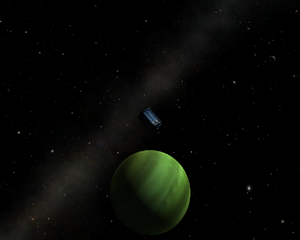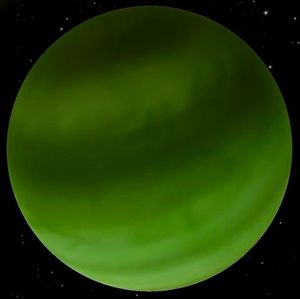Difference between revisions of "Jool"
From Kerbal Space Program Wiki
m (replaced speculation about Jool's atmosphere with personal knowledge) |
m (Fixed grammatical error.) |
||
| Line 45: | Line 45: | ||
== Atmosphere == | == Atmosphere == | ||
| − | Although Jool has a radius 10x bigger than Kerbin, | + | Although Jool has a radius 10x bigger than Kerbin, its atmosphere only begins roughly twice as high (140 km). It is also extremely dense, well suited for aerobraking from a high-speed inter-planetary intercept. |
== Natural Satellites == | == Natural Satellites == | ||
Revision as of 16:34, 21 September 2012
Jool is a gas giant and the fifth planet of the Kerbolar star system.Characteristics
- Equatorial Radius: 6000 km
- Mass: 4.236e24 kg
- Density: 4.68 g/cm³
- Surface Gravity: 7.84 m/s² (0.8 Gs)
- Gravitational parameter: 2.8254e14 m³/s²
- Escape velocity from surface: 9704 m/s
- Sidereal Rotation Period: ... hours; Rotation: ... degrees per hour, or ... m/s at the equator
- Solar Day: ... hours, or ... hours, ... seconds.
- Synchronous Orbit altitude: ... km; Stationary Orbit velocity: ... m/s
Orbital Characteristics
- Semi-Major Axis: 6.87e10 m or 0.46 Astronomical Units (A.U.)
- Eccentricity: ...
- Inclination: 1.3°
- Velocity: ... m/s
- Argument of Periapsis: ...°
- Mean Anomaly at Epoch UT = ...
- Orbital Period: ... hours, or ... Earth days
- Sphere of influence: 2,455,985 km, or 409 body radii.
Atmosphere
Although Jool has a radius 10x bigger than Kerbin, its atmosphere only begins roughly twice as high (140 km). It is also extremely dense, well suited for aerobraking from a high-speed inter-planetary intercept.
Natural Satellites
Jool has four natural satellites: the ocean moon Laythe, the ice moon Vall, the rocky moon Tylo and Bop. Laythe, Vall, and Tylo are in a Laplace resonance, with orbital periods of 1:2:4 respectively.

